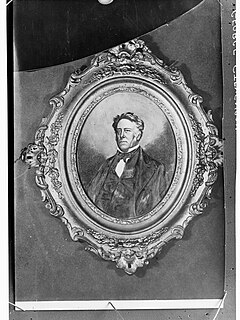Related Research Articles

Charles Napier Sturt was a British officer and explorer of Australia, and part of the European exploration of Australia. He led several expeditions into the interior of the continent, starting from Sydney and later from Adelaide. His expeditions traced several of the westward-flowing rivers, establishing that they all merged into the Murray River, which flows into the Southern Ocean. He was searching to prove his own passionately held belief that an "inland sea" was located at the centre of the continent. He reached the rank of Captain, served in several appointed posts, and on the Legislative Council.

The Province of South Carolina was originally part of the Province of Carolina in British America, which was chartered by eight Lords Proprietor in 1663. The province later became the U.S. state of South Carolina.

The Waterloo Creek massacre refers to a series of violent clashes between mounted police, civilian vigilantes and Indigenous Gamilaraay peoples, which occurred southwest of Moree, New South Wales, Australia, during December 1837 and January 1838. The events have been subject to much dispute, due to wildly conflicting accounts by various participants and in subsequent reports and historical analyses, about the nature and number of fatalities and the lawfulness of the actions. Interpretation of the events at Waterloo Creek was raised again during the controversial "history wars" which began in the 1990s in Australia.
The South Australian Company, also referred to as the South Australia Company, was formed in London on 9 October 1835, after the South Australia (Foundation) Act 1834 had established the new British Province of South Australia, with the South Australian Colonization Commission set up to oversee implementation of the Act.

The Register, originally the South Australian Gazette and Colonial Register, and later South Australian Register, was South Australia's first newspaper. It was first published in London in June 1836, moved to Adelaide in 1837, and folded into The Advertiser almost a century later in February 1931.

George Stevenson was a pioneer South Australian newspaper editor and horticulturist.

Grevillea flexuosa, commonly known as zigzag grevillea or tangled grevillea, is an endangered shrub endemic to Western Australia.

The Treasurer of New South Wales, known from 1856 to 1959 as the Colonial Treasurer of New South Wales, is the minister in the Government of New South Wales responsible for government expenditure and revenue raising and is the head of the New South Wales Treasury. The Treasurer plays a key role in the economic policy of the government.

The New South Wales Minister for Education and Early Childhood Learning is a minister in the New South Wales Government and has responsibilities that includes all schools and institutes of higher education in New South Wales, Australia.
The South Australian was a newspaper published in Adelaide, the capital of colonial South Australia from 2 June 1838 to 19 August 1851. Between 1838 and 1844, it was published as The Southern Australian.

Pullen Island is a 1 ha granite island lying 0.5 km offshore from the town of Port Elliot on the southern coast of the Fleurieu Peninsula of South Australia. It was originally named Lipson Island but was renamed in 1839 by W.J.S. Pullen, the Colonial Marine Surveyor, after himself. The island is protected by designation as the Pullen Island Conservation Park.

The Postmaster-General of New South Wales was a position in the government of the colony of New South Wales. This portfolio managed the postal department of the New South Wales Government and was in charge of all postal and communications services in the colony prior to the Federation of Australia, from 1835 to 1901. Upon Federation, Section 51(v) of the Constitution of Australia gave the Commonwealth exclusive power for "postal, telegraphic, telephonic, and other like services".

The Australian was an English language newspaper published in Sydney, Australia.
This is a list of members of the South Australian Legislative Council from 1836 to 1843. Beginning with the arrival of John Hindmarsh on 28 December 1836, there were five members of the Council of Government, both Executive and Legislative, consisting of: the Governor, Judge, Colonial Secretary, Advocate-General, and Resident Commissioner until 4 December 1838. From the latter date until 20 February 1843, the officials were: the Governor and Resident Commissioner, Colonial Secretary, Advocate-General, Surveyor-General, and Assistant Commissioner of Lands.
The Aboriginal South Australians are the Indigenous people who lived in South Australia prior to the British colonisation of South Australia, and their descendants and their ancestors. There are difficulties in identifying the names, territorial boundaries, and language groups of the Aboriginal peoples of South Australia, including poor record-keeping and deliberate obfuscation, so only a rough approximation can be given here.

Barndioota is a locality and former town in the southern Flinders Ranges west of Hawker. The bounded locality of Barndioota which corresponds to the cadastral Hundred of Barndioota, also includes the former town of Hookina and the site of the ceased Government Town of Barndioota which was surveyed in 1883 and declared ceased to exist in 1929.
The South Australian Gazette And Colonial Register was the name of two different publications in early South Australia. Both later changed their name.
The Adelaide Chronicle was an early publication in Adelaide, the capital of the then colony of South Australia. It was published between 1839 and 1842, when it ceased publication as a result of the economic depression caused by the mass exodus of workers to the Victorian goldfields.
The South Australian Gazette and Colonial Register and South Australian Gazette and Mining Journal was a weekly publication in the colony of South Australia which included notices from and about the government between 1845 and 1852.
References
- 1 2 "Gazette History | Government Gazette". www.governmentgazette.sa.gov.au. Retrieved 22 January 2017.